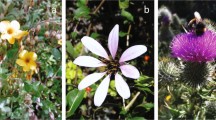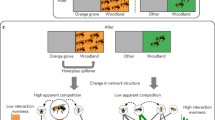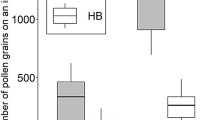Abstract
Introduced honeybees have had a large impact on native ecosystems by disrupting native plant–pollinator interactions. However, little is known of the effect of honeybees on reproduction of bumblebee-pollinated plants. Seasonal displacement of native bumblebees by introduced honeybees (Apis mellifera and A. cerana) was observed in Pedicularis densispica, endemic to Hengduan Mountains, China, providing an opportunity for honeybee presence/absence comparisons. Five-year field surveys were conducted in one frequently disturbed population at Yila Pasture (YP). We compared pollination effectiveness (combinations of visitation rate, efficiency in pollen transfer, and potential geitonogamy) between native and introduced managed bees. The total visitation rate of native bees and subsequent reproductive output decreased progressively, but honeybee introduction resulted in at least twofold increase in visitation and 70 % increase in seed set. In general, native bumblebees, which have larger bodies and longer proboscises and spent more time probing single flowers, were more efficient than honeybees in terms of pollen removal and pollen deposition during first visits to virgin flowers. Compared with bumblebees, honeybees visited markedly fewer flowers in sequence within individual plants, potentially reducing geitonogamous pollination. Our data highlight that introduced honeybees can provide pollination service in terms of both quantity and quality for P. densispica. We suggest honeybee introduction as an effective way to augment pollination of P. densispica at disturbed and isolated sites.






Similar content being viewed by others
References
Abe T, Wada K, Kato Y, Makino S, Okochi I (2011) Alien pollinator promotes invasive mutualism in an insular pollination system. Biol Invasions 13:957–967
Barthell JF, Randall JM, Thorp RW, Wenner AM (2001) Promotion of seed set in yellow star-thistle by honey bees: evidence of an invasive mutualism. Ecol Appl 11:1870–1883
Cayuela L, Ruiz-Arriaga S, Ozers CP (2011) Honeybees increase fruit set in native plant species important for wildlife conservation. Environ Manag 48:910–919
Chen YC (1993) Apiculture in China. China Agriculture, Beijing
de Jong TJ, Waser NM, Klinkhamer PGL (1993) Geitonogamy: the neglected side of selfing. Trends Ecol Evol 8:321–325
Dick CW (2001) Genetic rescue of remnant tropical trees by an alien pollinator. Proc R Soc London B 268:2391–2396
Dieringer G (1992) Pollinator effectiveness and seed set in populations of Agalinis strictifolia (Scrophulariaceae). Am J Bot 79:1018–1023
Dohzono I, Yokoyama J (2010) Impacts of alien bees on native plant–pollinator relationships: a review with special emphasis on plant reproduction. Appl Entomol Zool 45:37–47
Dohzono I, Kunitake YK, Yokoyama J, Goka K (2008) Alien bumble bee affects native plant reproduction through interactions with native bumble bees. Ecology 89:3082–3092
Duan YW, Liu JQ (2007) Pollinator shift and reproductive performance of the Qinghai-Tibetan Plateau endemic and endangered Swertia przewalskii (Gentianaceae). Biodiv Conserv 16:1839–1850
Dupont YL, Hansen DM, Valido A, Olesen JM (2004) Impact of introduced honey bees on native pollination interactions of the endemic Echium wildpretii (Boraginaceae) on Tenerife, Canary Islands. Biol Conserv 118:301–311
England PR, Beynon F, Ayre DJ, Whelan RJ (2001) A molecular genetic assessment of mating-system variation in a naturally bird-pollinated shrub: contributions from birds and introduced honeybees. Conserv Biol 15:1645–1655
Eriksen B, Molau U, Svensson M (1993) Reproductive strategies in 2 arctic Pedicularis species (Scrophulariaceae). Ecography 16:154–166
Forup ML, Memmott J (2005) The restoration of plant–pollinator interactions in hay meadows. Restor Ecol 13:265–274
Freitas BM, Paxton RJ (1998) A comparison of two pollinators: the introduced honey bee Apis mellifera and an indigenous bee Centris tarsata on cashew Anacardium occidentale in its native range of NE Brazil. J Appl Ecol 35:109–121
Galloway LF, Bramucci M, Grattapaglia D (2003) Outcrossing rate and inbreeding depression in the herbaceous autotetraploid, Campanula americana. Heredity 90:308–315
Goodell K, Thomson JD (2007) Influence of bee species (Hymenoptera: Apiformes) with contrasting behaviors on pollen movement in a mustard, Brassica rapa (Brassicaceae) and the muskmelon Cucumis melo (Cucurbitaceae). Entomol Gen 29:237–252
Goulson D (2003) Effects of introduced bees on native ecosystems. Annu Rev Ecol Evol Syst 34:1–26
Goulson D, Stout JC, Kells AR (2002) Do alien bumblebees compete with native flower-visiting insects in Tasmania? J Insect Conserv 6:179–189
Gross CL (2001) The effect of introduced honeybees on native bee visitation and fruit-set in Dillwynia juniperina (Fabaceae) in a fragmented ecosystem. Biol Conserv 102:89–95
Gross CL, Mackay D (1998) Honeybees reduce fitness in the pioneer shrub Melastoma affine (Melastomataceae). Biol Conserv 86:169–178
Hansen DM, Olesen JM, Jones CG (2002) Tree, birds and bees in Mauritius: exploitative competition between introduced honey bees and endemic nectarivorous birds? J Biogeogr 29:721–734
Harder LD, Barrett SCH (1995) Mating cost of large floral displays in hermaphrodite plants. Nature 373:512–515
Herrera CM (1989) Pollinator abundance, morphology, and flower visitation rate: analysis of the “quality” component in a plant–pollinator system. Oecologia 80:241–248
Herrera CM (1996) Floral traits and plant adaptation to insect pollinators: a devil’s advocate approach. In: Lloyd DG, Barrett SCH (eds) Floral biology: studies on floral evolution in animal-pollinated systems. Chapman & Hall, New York, pp 65–87
Herrera CM (2000) Flower-to-seedling consequences of different pollination regimes in an insect-pollinated shrub. Ecology 81:15–29
Hingston AB, McQuillan PB (1999) Displacement of Tasmanian native megachilid bees by the recently introduced bumblebee Bombus terrestris (Linnaeus, 1758) (Hymenoptera: Apidae). Aust J Zool 47:59–65
Huang SQ, Fenster CB (2007) Absence of long-proboscid pollinators for long-corolla-tubed Himalayan Pedicularis species: implications for the evolution of corolla length. Int J Plant Sci 168:325–331
Inouye DW, Gill DE, Dudash MR, Fenster CB (1994) A model and lexicon for pollen fate. Am J Bot 81:1517–1530
Ivery CT, Martinez P, Wyatt R (2003) Variation in pollinator effectiveness in swamp milkweed, Asclepias incarnata (Apocynaceae). Am J Bot 90:215
Johnson SD, Steiner KE (1997) Long-tongued fly pollination and evolution of floral spur length in the Disa draconis complex (Orchidaceae). Evolution 51:45–53
Kato M, Shibata A, Yasui T, Nagamasu H (1999) Impact of introduced honeybees, Apis mellifera, upon native bee communities in the Bonin (Ogasawara) Islands. Res Popul Ecol 41:217–228
Kearns CA, Inouye DW (1993) Techniques for pollination biologist. University Press of Colorado, Colorado
Kearns CA, Inouye DW, Waser NM (1998) Endangered mutualisms: the conservation of plant–pollinator interactions. Annu Rev Ecol Syst 29:83–112
Kenta T, Inari N, Nagamitsu T, Goka K, Hiura T (2007) Commercialized European bumblebee can cause pollination disturbance: an experiment on seven native plant species in Japan. Biol Conserv 134:298–309
Kruszewski LJ, Galloway LF (2006) Explaining outcrossing rate in Campanulastrum americanum (Campanulaceae): geitonogamy and cryptic self-incompatibility. Int J Plant Sci 167:455–461
Larsson M (2005) Higher pollinator effectiveness by specialist than generalist flower-visitors of unspecialized Knautia arvensis (Dipsacaceae). Oecologia 146:394–403
Li H (1951) Evolution in the flowers of Pedicularis. Evolution 5:158–164
Liao K, Gituru RW, Guo YH, Wang QF (2011) The presence of co-flowering species facilitates reproductive success of Pedicularis monbeigiana (Orobanchaceae) through variation in bumble-bee foraging behaviour. Ann Bot 108:877–884
Liu H, Pemberton RW (2009) Solitary invasive orchid bee outperforms co-occurring native bees to promote fruit set of an invasive Solanum. Oecologia 159:515–525
Liu J, Ji T, Yin L, Liu M, Yu LS (2010) The comparative analysis of the main indexes of external morphology for 6 Apis cerana populations from Yunnan. Apic China 61:8–10
Lloyd DG (1992) Self- and cross-fertilization in plants. II. The selection of self-fertilization. Int J Plant Sci 153:370–380
Lopezaraiza-Mikel ME, Hayes RB, Whalley MR, Memmott J (2007) The impact of an alien plant on a native plant-pollinator network: an experimental approach. Ecol Lett 10:539–550
Luo LJ, Tan K (2008) Morphology and taxonomy of Apis cerana in Deqin. J Yunnan Agric Univ 23:230–232
Macior LW, Tang Y, Jian CZ (2001) Reproductive biology of Pedicularis (Scrophulariaceae) in the Sichuan Himalaya. Plant Spec Biol 16:83–89
Madjidian JA, Morales CL, Smith HG (2008) Displacement of a native by an alien bumblebee: lower pollinator efficiency overcome by overwhelmingly higher visitation frequency. Oecologia 156:835–845
Mitchell RJ, Irwin R, Flanagan RJ, Karron JD (2009) Ecology and evolution of plant–pollinator interactions. Ann Bot 103:1355–1363
Mustajarvi K, Siikamaki P, Rytkonen S, Lammi A (2001) Consequences of plant population size and density for plant–pollinator interactions and plant performance. J Ecol 89:80–87
Nilsson CH (1988) The evolution of flowers with deep corolla tubes. Nature 334:147–149
Paini DR (2004) Impact of the introduced honey bee (Apis mellifera) (Hymenoptera: Apidae) on native bees: a review. Aust Ecol 29:399–407
Paini DR, Roberts JD (2005) Commercial honey bees (Apis mellifera) reduce the fecundity of an Australian native bee (Hylaeus alcyoneus). Biol Conserv 123:103–112
Paton DC (1995) Impact of honeybees on the flora and fauna of Banksia heathlands in Ngarkat Conservation Park. STATA J 95:3–11
Ree RH (2005) Phylogeny and the evolution of floral diversity in Pedicularis (Orobanchaceae). Int J Plant Sci 166:595–613
Roubik DW (2002) Tropical agriculture—the value of bees to the coffee harvest. Nature 417:708
Rymer PD, Whelan RJ, Ayre DJ, Weston PH, Russell KG (2005) Reproductive success and pollinator effectiveness differ in common and rare Persoonia species (Proteaceae). Biol Conserv 123:521–532
SAS Institute (2012) JMP version 10.0. SAS Institute, Cary, NC, USA
Schemske DW, Bradshaw HD (1999) Pollinator preference and the evolution of floral traits in monkeyflowers (Mimulus). Proc Natl Acad Sci USA 96:11910–11915
Snow A, Roubik AD (1987) Pollen deposition and removal by bees visiting two tropical tree species in Panama. Biotropica 19:57–63
Spears EE (1983) A direct measure of pollinator effectiveness. Oecologia 57:196–199
Stang M, Klinkhamer PGL, Waser NM, Stang I, van der Meijden E (2009) Size-specific interaction patterns and size matching in a plant–pollinator interaction web. Ann Bot 103:1459–1469
Stebbins GL (1971) Chromosomal evolution in higher plants. Edward Arnold, London
Stout JC, Kells AR, Goulson D (2002) Pollination of the invasive exotic shrub Lupinus arboreus (Fabaceae) by introduced bees in Tasmania. Biol Conserv 106:425–434
Sun SG (2005) Studies on pollination ecology of Pedicularis (Orobanchaceae) in Hengduan Mountains regions. Dissertation, Wuhan University
Sun SG, Guo YH, Gituru RW, Huang SQ (2005a) Corolla wilting facilitates delayed autonomous self-pollination in Pedicularis dunniana (Orobanchaceae). Plant Syst Evol 251:229–237
Sun SG, Liao K, Xia J, Guo YH (2005b) Floral colour change in Pedicularis monbeigiana (Orobanchaceae). Plant Syst Evol 255:77–85
Thomson JD (1986) Pollen transport and deposition by bumblebees in Erythronium: influences of floral nectar and bee grooming. J Ecol 74:329–341
Thomson D (2004) Competitive interactions between the invasive European honey bee and native bumble bees. Ecology 85:458–470
Thomson JD, Goodell K (2001) Pollen removal and deposition by honeybee and bumblebee visitors to apple and almond flowers. J Appl Ecol 38:1032–1044
Traveset A, Richardson DM (2006) Biological invasions as disruptors of plant reproductive mutualisms. Trends Ecol Evol 21:208–216
Tsyganov SK (1953) Remarks on the pollinating activity of honey bees. Akad Nauk Inst, Uzbekistan
Utelli AB, Roy BA (2000) Pollinator abundance and behavior on Aconitum lycoctonum (Ranunculaceae): an analysis of the quantity and quality components of pollination. Oikos 89:461–470
Vaughton G (1996) Pollination disruption by European honeybees in the Australian bird-pollinated shrub Grevillea barklyana (Proteaceae). Plant Syst Evol 200:89–100
Wang H, Li DZ (2005) Pollination biology of four Pedicularis species (Scrophulariaceae) in northwestern Yunnan, China. Ann Mo Bot Garden 92:127–138
Wang H, Yu WB, Chen JQ, Blackmore S (2009) Pollen morphology in relation to floral types and pollination syndromes in Pedicularis (Orobanchaceae). Plant Syst Evol 277:153–162
Williams NM, Thomson JD (2003) Comparing pollinator quality of honey bees (Hymenoptera: Apidae) and native bees using pollen removal and deposition measures. In: Stickler K, Cane JH (eds) For nonnative crops, whence pollinators of the future?. Entomological Society of America, Lanham, pp 163–179
Wilson EO (1992) The diversity of life. Harvard University Press, Cambridge
Wilson P, Thomson JD (1991) Heterogeneity among floral visitors leads to discordance between removal and deposition of pollen. Ecology 72:1503–1507
Xia J, Sun SG, Guo YH (2007) Honeybees enhance reproduction without affecting the outcrossing rate in endemic Pedicularis densispica (Orobanchaceae). Plant Biol 9:713–719
Yang FS, Wang XQ (2007) Extensive length variation in the cpDNA trnT–trnF region of hemiparasitic Pedicularis and its phylogenetic implications. Plant Syst Evol 264:251–264
Yang HB, Holmgren NH, Mill RR (1998) Pedicularis. In: Wu CY, Raven PH (eds) Flora of China. Science Press/Missouri Botanical Garden Press, Beijing/St. Louis, pp 97–209
Yang CF, Guo YH, Gituru RW (2002) Variation in stigma morphology—how does it contribute to pollination adaptation in Pedicularis (Orobanchaceae)? Plant Syst Evol 236:89–98
Young HJ, Dunning DW, von Hasseln KW (2007) Foraging behavior affects pollen removal and deposition in Impatiens capensis (Balsaminaceae). Am J Bot 94:1267–1271
Acknowledgments
We thank Kuo Liao, Xiao-Xin Tang, Rui-Fang Yang, Chi-Yuan Yao, and Jia-Xi Cai for their assistance in the field and in the laboratory, and Bang-Yu Kuang for identifying bee species. This work was supported by the State Key Basic Research and Development Plan of China (grant number G2000046804) and Leading Academic Discipline Project of Shanghai Municipal Education Commission (grant numbers J50401, SK201003, and RE951).
Author information
Authors and Affiliations
Corresponding author
Rights and permissions
About this article
Cite this article
Sun, SG., Huang, SQ. & Guo, YH. Pollinator shift to managed honeybees enhances reproductive output in a bumblebee-pollinated plant. Plant Syst Evol 299, 139–150 (2013). https://doi.org/10.1007/s00606-012-0711-8
Received:
Accepted:
Published:
Issue Date:
DOI: https://doi.org/10.1007/s00606-012-0711-8




